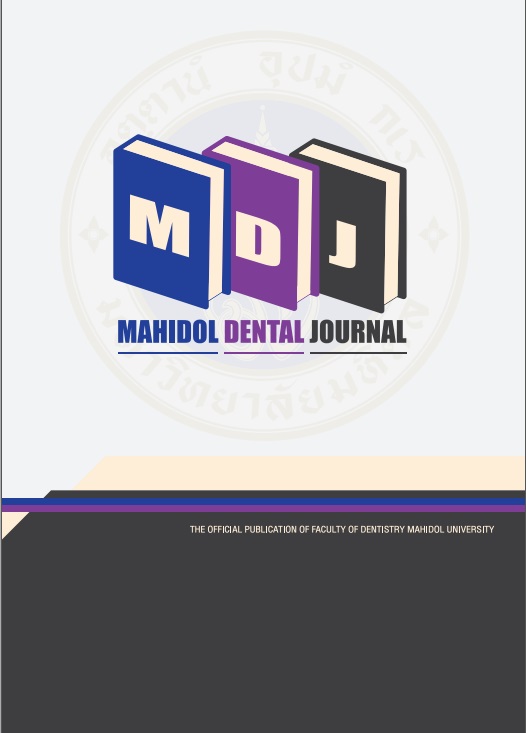Benefits of pit and fissure sealants on fluoride release, buffering capacity, and biofilm formation
Main Article Content
Abstract
Objective: Antibacterial property of pit and fissure sealant enhance the positive effect for caries prevention.
The aims of this study were to investigate the fluoride release, buffering capacity, and biofilm formation of sealants.
Materials and Methods: Specimens from BeautiSealant (giomer-based sealant), ClinproTM (fluoride releasing resin-based sealant), Fuji VII (glass-ionomer-based sealant), and Concise (nonfluoride releasing resin-based sealant) were prepared. Studies of the specimen were conducted to examine fluoride released, buffering capacity and formation of S. mutans biofilm, which involved examining the biovolume and live/dead cell ratios.
Results: Fuji VII released the highest amount of fluoride (11.71 ppm), followed by BeautiSealant (6.20 ppm),
Clinpro (1.27 ppm), and Concise (0.02 ppm). The smallest change in pH was found in BeautiSealant (-1.35),
followed by Fuji (-1.85), Clinpro (-2.11), and Concise (-2.67). There was a higher biovolume of biofilms on Concise (0.0177 mm3mm-2) than the other materials. Thus, the live/dead cell ratio on the BeautiSealant biofilms (0.5554) was less than on the other materials.
Conclusions: BeautiSealant demonstrated benefit in reducing the biovolume of biofilm and the live/dead cell
ratio with a high buffering capacity.
Article Details
References
Griffin SO, Gray SK, Malvitz DM, Gooch BF. Caries risk in formerly sealed teeth. J Am Dent Assoc 2009; 140: 415-23.
Ahovuo-Saloranta A, Forss H, Walsh T, Nordblad A, Mäkelä M, Worthington HV. Sealants for preventing dental decay in the permanent teeth. Cochrane Database Syst Rev 2013; 3: Cd001830.
Mejàre I, Lingström P, Petersson LG, Holm AK, Twetman S, Källestål C, et al. Caries-preventive effect of fissure sealants: a systematic review. Acta Odontol Scand 2003; 61: 321-30.
Matalon S, Peretz B, Sidon R, Weiss EI, Slutzky H. Antibacterial properties of pit and fissure sealants combined with daily fluoride mouth rinse. Pediatr Dent 2010; 32: 9-13.
Loyola-Rodriguez JP, Garcia-Godoy F. Antibacterial activity of fluoride release sealants on mutans streptococci. J Clin Pediatr Dent 1996; 20: 109-11.
Petrovski KR, Caicedo-Caldas A, Williamson NB, Lopez-Villalobos N, Grinberg A, Parkinson TJ, et al. Efficacy of a novel internal dry period teat sealant containing 0.5% chlorhexidine against experimental challenge with Streptococcus uberis in dairy cattle. J Dairy Sci 2011; 94: 3366-75.
Yang SY, Piao YZ, Kim SM, Lee YK, Kim KN, Kim KM. Acid neutralizing, mechanical and physical properties of pit and fissure sealants containing melt-derived 45S5 bioactive glass. Dent Mater 2013; 29: 1228-35.
Al-Naimi RJ, Al-Alousi WS, Al-Nema M. Effect of silver and zinc oxide nanoparticle addition on microhardness and depth of cure of resin-based pit and fissure sealants. IJERSTE 2015; 4: 157-63.
Naorungroj S, Wei HH, Arnold RR, Swift EJ Jr, Walter R. Antibacterial surface properties of fluoride-containing resin-based sealants. J Dent 2010; 38: 387-91.
Shin SW, Kim JS. Microleakage and anticariogenic effect of S-PRG filler-containing pit and fissure sealant. J Korean Acad Pediatr Dent 2013; 40: 247-52.
Mickenautsch S, Yengopal V. Caries-preventive effect of high-viscosity glass ionomer and resin-based fissure sealants on permanent teeth: a systematic review of clinical trials. PLoS One 2016; 11: e0146512.
Kühnisch J, Mansmann U, Heinrich-Weltzien R, Hickel R. Longevity of materials for pit and fissure sealing - results from a meta-analysis. Dent Mater 2012; 28: 298-303.
Featherstone JD, Doméjean S. The role of remineralizing and anticaries agents in caries management. Adv Dent Res 2012; 24: 28-31.
Patil SS, Kontham UR, Kontham RK, Patil SS, Kamble SP. Fluoride release and fluoride-recharging ability of three different sealants. J Indian Soc Pedod Prev Dent 2020; 38: 247-52.
Salmerón-Valdés EN, Scougall-Vilchis RJ, Alanis-Tavira J, Morales-Luckie RA. Comparative study of fluoride released and recharged from conventional pit and fissure sealants versus surface pre-reacted glass ionomer technology. J Conserv Dent 2016; 19: 41-5.
Chen L, Zeng SJ, Li YH, Du MQ. Evaluation of ion release from four dental sealants. Curr Med Sci 2018; 38: 524-29.
Fujimoto Y, Iwasa M, Murayama R, Miyazaki M, Nagafuji A, Nakatsuka T. Detection of ions released from S-PRG fillers and their modulation effect. Dent Mater J 2010; 29: 392-97.
Duque C, Negrini Tde C, Hebling J, Spolidorio DM. Inhibitory activity of glass-ionomer cements on cariogenic bacteria. Oper Dent 2005; 30: 636–40.
Tegginmani VS, Goel B, Uppin V, Horatti P, Kumar LS, Nainani A. Comparison of antibacterial activity of glass-ionomer cement and amalgam in class two restorations by Streptococcus mutans count analysis at fixed intervals: an in vivo study. J Contemp Dent Pract 2013; 14: 381-86.
Nakajo K, Imazato S, Takahashi Y, Kiba W, Ebisu S, Takahashi N. Fluoride released from glass-ionomer cement is responsible to inhibit the acid production of caries-related oral streptococci. Dent Mater 2009; 25:703-708.
Najma Hajira NSW, Meena N. GIOMER- The Intelligent Particle (New Generation Glass Ionomer Cement). Int J Dent Oral Health 2015; 2: doi http://dx.doi.org/10.16966/2378-7090.166
Kaga M, Kakuda S, Ida Y, Toshima H, Hashimoto M, Endo K, et al. Inhibition of enamel demineralization by buffering effect of S-PRG filler- containing dental sealant. Eur J Oral Sci 2014; 122: 78–83.
Kondo Y, Ito S, Uehara O, Kurashige Y, Fujita Y, Saito T, et al. Chemical and biological properties of new sealant-use cement materials. Dent Mater 2019; 35: 673-85.
Cury JA, Tenuta LM. Enamel remineralization: controlling the caries disease or treating early caries lesions? Braz Oral Res 2009; 23(Suppl 1): 23-30.
Fejerskov O, Cury JA, Tenuta LMA, Marinho V. Fluorides in caries control. In: Fejerskov O, Kidd E, editors. Dental caries: the disease and its clinical management. third ed. Oxford: Wiley Blackwell; 2015. p. 245–76.


